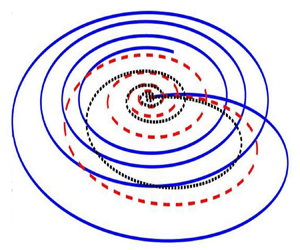No CrossRef data available.
Article contents
Stability analysis of electro-osmotic flow in a rotating microchannel
Published online by Cambridge University Press: 15 March 2024
Abstract

We investigate the linear stability analysis of rotating electro-osmotic flow in confined and unconfined configurations by appealing to the Debye–Hückel approximation. Pertaining to flow in confined and unconfined domains, the stability equations are solved using the Galerkin method to obtain the stability picture. Both qualitative and quantitative aspects of Ekman spirals are examined in stable and unstable scenarios within the unconfined domain. Within the confined domain, the variation of the real growth rate and the transition to instability are analysed using the modified Routh–Hurwitz criteria, employed for the first time in this context. The stability of the underlying flow, characterized by the number of roots with a positive real part, is determined by establishing a Routhian table. The inferences of this analysis show that the velocity plane produces intriguing closed Ekman spirals, which diminish in size with an increase in the rotation speed  $\omega$. The Ekman spirals in the stable region exhibit a distinct discontinuity, indicating the dissipation of disturbances over time. In the confined domain, the flow appears consistently stable for a set of involved parameters pertinent to this analysis, such as electrokinetic parameter
$\omega$. The Ekman spirals in the stable region exhibit a distinct discontinuity, indicating the dissipation of disturbances over time. In the confined domain, the flow appears consistently stable for a set of involved parameters pertinent to this analysis, such as electrokinetic parameter  $K=1.5$ and rotational parameter
$K=1.5$ and rotational parameter  $\omega$ approximately up to
$\omega$ approximately up to  $6$. However, the flow instabilities become evident for
$6$. However, the flow instabilities become evident for  $K=1.5$ and
$K=1.5$ and  $\omega \geq 6$.
$\omega \geq 6$.
- Type
- JFM Papers
- Information
- Copyright
- © The Author(s), 2024. Published by Cambridge University Press





